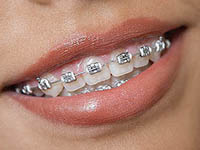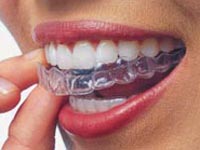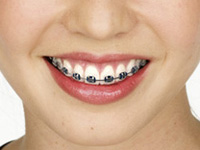Different Types of Braces – You have choices!
Dental technology has brought us to an exciting time with regards to dental braces. There are many types of braces from metal braces to ceramic braces, from tooth-colored braces to clear braces. It’s no longer a stage that is feared by teens everywhere. Many teens almost look forward to getting braces because it signifies a right-of-passage and shows that they’re not a kid anymore. Review the various types of braces below and fill out our braces referral form to the right to get started.
Metal Braces

Metal braces are the most commonly used braces and any orthodontist can provide this system of braces. The system involves brackets that are glued to each tooth. Read more about Metal Braces.
Ceramic Braces

Ceramic Braces are not as visible as metal braces. Ceramic braces are a little more expensive and they’re not as strong as metal braces, but they look great. Find out more information about Ceramic Braces.
Lingual Braces

Lingual Braces are attached behind the teeth so they’re not visible when you smile. Lingual braces are also more expensive than traditional metal braces but the advantages are apparent. Learn more about Lingual Braces.
Invisalign Clear Braces

Invisalign braces are virtually invisible. These alignment trays are created from molds and can be removed for brushing and flossing. They’re the Cadillac of braces if you can afford them. Read more about Invisalign Braces.
Smart Brackets

Smart brackets are the latest technology in braces. Intended to function as a braces system that provides measurements and information which can help reduce the total amount of time that the braces are worn.

About the Different Types of Braces
There are many different types of braces that can be placed on the teeth by an Orthodontist. But braces are a relatively new and unexplored area. Think about how old mankind has roamed this planet. And braces have only been around for a little more than 50 years. They are relatively a new discovery and the types of braces have really exploded in recent years.
In fact, braces have gone from the metal attachments all the way up to the newest type of braces in which you can remove them each night; Invisalign braces. Really the idea of braces has evolved from big apparatus’ like headgear all the way to those which are hidden behind the teeth. You can now put braces on and off in seconds. So it is important that when researching the types of braces that are available on the market by licensed Orthodontist, you research with an open mind or a clean slate.
2 Main Types of Braces – Attached and Removable
When you get down to the nitty-gritty, there are really 2 basic types of braces when boiled down. Those that are attached and those that are removable. And you may be thinking that the temporary ones (those that can be removed with ease) are going to be the best bet. But there are both pros and cons that go along with each type of Orthodontic Braces.
The Need for Different Types of Braces
There are so many different types of braces because there are multiple scenarios and factors that will affect the nature of teeth straightening. Not every case is the same and therefore you cannot use the same treatment on every person needing braces. Hence the different types! And with each passing year, it seems like Orthodontics as a whole is inventing new or bettering existing methods for straightening teeth with braces.
The type of braces that you need will hinge of a few elements and will also depend on what your Doctor suggests. You Orthodontist’s approach will be based on how serious your case is. In some extreme cases, the Orthodontist must have teeth removed, or some may require jaw changes with surgery or headgear. But with some cases, simple retainers may be used to shape your teeth. Of course, the time need for each case varies greatly.
You’re Opinion Matters
Do not be afraid to voice your opinion regarding the types of braces you are interested in. If you do not feel comfortable with braces that show, ask about other options like Lingual Braces or Invisalign which are hidden braces. Or if you want those cool colors go ahead and ask. Maybe you just want the fastest treatment possible or the cheapest. After all your Orthodontist is there to make you happy.
Invisalign Braces
Invisalign Braces are one of the newest brace types on the market. These are not braces like you are used to. Invisalign Braces are not permanent rather they are plastic clear retainers that are worn. This type of braces is most often used for those who have a simple case of crooked teeth. How it works is the Orthodontist takes measurements of your teeth, and then sends them out to have plastic trays made. You wear these plastic retainers for a while. On your next appointment, the Orthodontist repeats the process. This continues over time and slowly with each new Invisalign retainer, your teeth move into position.
Advantages and Disadvantages of Invisalign Braces
Advantages
- They are Invisible hence the name
- You can easily remove them meals and cleanings
- They are high tech and your treatment can be computer simulated
- They will not stain or damage your teeth
Disadvantages
- The price of Invisalign Braces can be high
- The length of time you wear the Invisalign retainers is the same as traditional types of braces
- It can take over a month for your Invisalign retainers to arrive
- Invisalign braces cannot be used on severe cases
Ceramic Braces
Ceramic braces are created by mixing a couple of inorganic materials together to create a new material. This permanent type of braces is applied by affixing them to each individual tooth. An archwire then spans the length of the upper and lower set of teeth. The wire is then tied to the ceramic braces by rubber bands which are also called ligatures. Ceramic braces are one of the most widely used braces types.
Traditional metal braces are increasingly being replaced by ceramic braces. They function the same as metal braces but offer a less conspicuous look since the ceramic material is created in a variety of colors to better match your tooth color. They are also quite tough as the ceramic has the strength of concrete. Applying ceramic braces is very labor intensive. This is done in the Orthodontist office.
Advantages and Disadvantages of Ceramic Braces
Advantages
- The ceramic material comes in many shades and thus blends in nicely with your teeth.
- Ceramic braces are permanently attached and offer a more comfortable experience
- The material is strong and breaking one is very unlikely
- The rubber bands can be exchanged with ease
- Ceramic braces can fit on a high percentage of patients
Disadvantage
- They cost a bit more than metal braces
- The length you have these installed may last a bit longer
- Each individual ceramic brace is larger than some of the other types of permanent braces
- Ceramic braces do have their limitations
Lingual Braces
Lingual braces are totally invisible in that they are placed on the inside of the teeth rather than the outside. It’s a novel idea if you think about it. Instead of making the color of the braces the same as the teeth as ceramic braces do, Lingual braces try to hide altogether by residing on the inside of your teeth.
It takes a highly skilled Orthodontist to install this type of braces. Metal brackets are used and the same techniques are applied just on the opposite side. In reality, the Lingual type of braces has more downsides than ups.
Advantages and Disadvantages of Lingual Braces
Advantages
- Lingua Braces are totally hidden since the bracket is on the inside of the tooth
Disadvantages
- Lingua Braces are irritating to the tongue
- There are not many Orthodontists who can do this procedure
- It can take a long time
- Only a small percentage of people are good candidates for Lingua Braces
